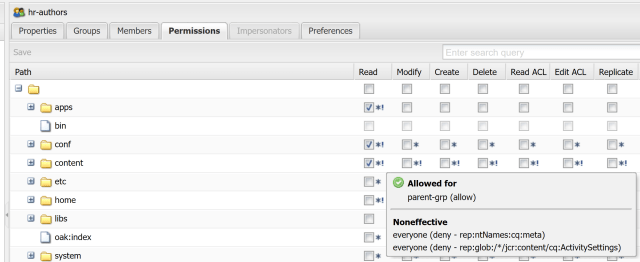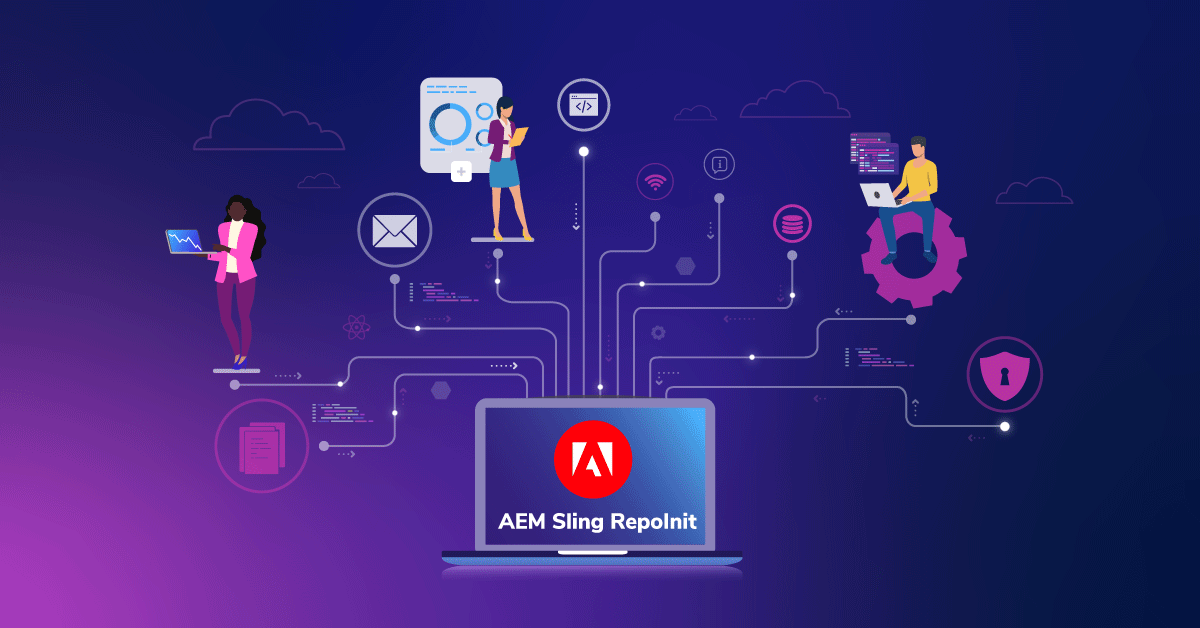Adobe Experience Manager (AEM) is a powerful content management solution used by many organizations to manage their digital assets and web content. One crucial aspect of managing content in AEM is controlling access to resources using Access Control Lists (ACLs). However, troubleshooting ACL-related issues can be challenging, especially for users who are new to AEM. In this blog post, weРђЎll explore common ACL-related problems in AEM and provide practical troubleshooting tips to resolve them.
What are the various types of permissions?
On high level, permissions are divided into following categories as depicted by the Image.

Each of these permissions is a composition of more granular JCR permissions.
For example, the РђюDeleteРђЮ permission consists of two JCR permissions:
- jcr:removeNode: The privilege to remove a node.
- jcr:removeChildNodes: The privilege to remove child nodes of a node.
Read:

Modify:

Create:

Delete:

Read ACL:

Edit ACL:

Replicate:

Thus, you might encounter projects that use define permissions via high-level (read, modify) or low-level (jcr:read, jcr:addChildNodes) etc.Typically, working with higher-level permissions is preferable due to their simplicity and ease of maintenance. However, there may be instances where dealing with lower-level permissions becomes necessary to meet specific requirements. Example: Allow users to reset password, we need to provide jcr:modifyProperties privilege on /home/groups. It is provided via granular access , while avoiing complete edit access on Groups.
Effective and Ineffective permissions.
Before we troubleshoot ACLS, we would first need to understand what an overall access on a node consists of.
When a user is a member of multiple groups with differing permissions on a specific node, the overall permissions are determined by various combinations. This complexity can arise from group inheritance or the user belonging to multiple groups. HereРђЎs a breakdown:
A РђюLocal EntryРђЮ indicates that permissions have been manually updated on a particular node, rather than being inherited from a parent node.
РђюEffective PermissionРђЮ refers to permissions being applied according to the group permission configuration. For instance, if a group has an РђюallowРђЮ permission on a node, the user admin will display РђюallowРђЮ for users who are members of that group.
Conversely, РђюIneffective PermissionРђЮ occurs when permissions are not applied as per the group permission configuration. For example, if there are conflicting permissions on a node where one group has an РђюallowРђЮ permission and another has a РђюdenyРђЮ permission, the user admin may display РђюallowРђЮ for the user who is a member of both groups. In this case, the effective permission is the РђюallowРђЮ from group A, and the ineffective permission is the РђюdenyРђЮ from group B.
In useradmin, an asterisk (*) is used to denote effective-only scenarios, while both an asterisk (*) and an exclamation mark (!) indicate ineffective or effective + ineffective combinations.

Troubleshooting Tips and Techniques:
Here are some practical steps and techniques to troubleshoot and resolve ACL-related challenges effectively:
- Verify User Group Memberships:┬аEnsure that users belong to the correct groups with appropriate permissions. Incorrect group memberships can lead to unexpected access issues.
- Inspect Resource ACLs:┬аUse tools like Useradmin, Access Control Editor or Permissions UI to examine the ACLs applied directly to the resource and its parent nodes. This helps identify any misconfigurations or conflicts in permissions.
- Links to tools are available here:┬аhttps://techrevel.blog/2024/03/04/from-setup-to-migration-the-best-tools-for-acl-management-in-aem/#tool-links
- Useradmin and Access Control Editor are only available on AEM 6.5 and local cloud SDK
- Analyze Inheritance:┬аAnalyze the effective/ineffective permissions via Useradmin and identify potential conflicts that may arise from inherited permissions. Analyzing inheritance can provide insights into unexpected access behaviors.
- Utilize Test User:┬аCreate a test user with minimum groups. Gradully add more groups to understand where the issue lies.
By following these troubleshooting tips and techniques, AEM administrators, developers, and support teams can efficiently identify and resolve ACL-related issues, ensuring a secure and seamless user experience within the AEM platform.
Additional Resources:
- For tips on how to Effectively manage ACLs, visit┬аAEM User Permissions: Tips for Effortless┬аControl
Рђ╗Тќ░УЦ┐тЁ░тЁеТљюу┤б┬Е№ИЈуЅѕТЮЃТЅђТюЅ
ТЋгУ»итЁ│Т│еТќ░УЦ┐тЁ░тЁеТљюу┤бNew Zealand Review тюетљётцДуцЙС║цтфњСйЊт╣│тЈ░уџётЁгС╝ЌтЈисђѓС╗јУ┐ЎжЄїУ»╗ТЄѓТќ░УЦ┐тЁ░№╝Ђ№ИЈ

тдѓТъюТѓетќюТгбТѕЉС╗гуџёТќЄуФа№╝їУ»иТћ»ТїЂТѕЉС╗гуџёТќ░жЌ╗тиЦСйюУђЁтњїтѕЏСйюУђЁ№╝ЂУ»иТЅЊУхЈСИђТЮ»тњќтЋАу╗ЎС╗ќС╗г№╝ѕТ│еТўјТаЈуЏ«ТѕќТќЄуФажбўуЏ«№╝Ѕ№╝їТѕќТћ»ТїЂТѕЉС╗гТ»ЈТюѕуџёТюЇтіАтЎеУ┤╣уће№╝їжЮътИИТёЪУ░б№╝Ђ
У«бжўЁТѕЉС╗г№╝їPaypalТ»ЈТюѕУхътіЕ5у║йтИЂ№╝џ
http://bit.ly/47fUCPS
С║єУДБ Тќ░УЦ┐тЁ░тЁеТљюу┤бЪћЇ уџёТЏ┤тцџС┐АТЂ»
У«бжўЁтљјтЇ│тЈ»жђџУ┐ЄућхтГљжѓ«С╗ХТћХтѕ░ТюђТќ░ТќЄуФасђѓ



